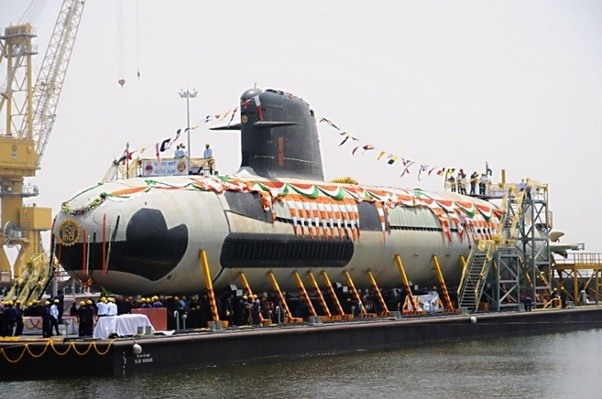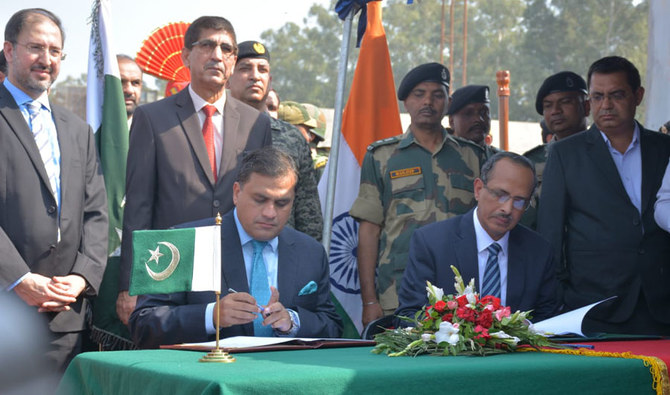Regarded as a very prestigious acquisition, INS Kalvari is the most potent platform to have been constructed in India. The construction of the Submarine, designated as MDL Yard 11875 commenced with the first cutting of steel at MDL on 14 Dec 2006. The ‘Boot Together’ of the submarine wherein the five separate sections were welded into one was completed on 30 Jul 2014. Interestingly she is the first Indian Naval vessel to be built using this modular approach of construction. She was hauled out on Pontoon from the Eof construction of MDL in the presence of the then Defence Minister Shri Manohar Parrikar on 06 Apr 2015. The submarine was ‘launched’ and christened as ‘Kalvari’ on 27 Oct 2015 by Mrs. Ritu Shrawat, wife of then CMD, MDL, R Adm RK Shrawat (Retd.) by striking a coconut on the hull with a Sanskrit invocation from the Atharva Veda to the Goddess Aditi, mother of the Sun God Surya (Aditya). Kalvari first put to sea on 01 May 2016. She has since undergone a comprehensive trial schedule to validate her capability to Float, to Move, and to Fight Towards the last, she has undertaken successful torpedo launch as well as the Navy’s maiden SM 39 Exocet combat missile firing on 02 Mar 2017. The formal delivery of the boat to the Indian Navy is the last milestone before Commissioning. On completion of trials, the boat was delivered to the Indian Navy by MDL on 21 Sep 2017.
Kalvari is a potent Man o’ War capable of undertaking offensive operations spanning across the entire spectrum of Maritime Warfare. She embodies cutting edge technology and compares favourably with the best in the world. She has an overall length of 67.5 metres and a height of about 12.3 metres. The hull form, the fin and the hydroplanes are specifically designed to produce minimum underwater resistance. Her 360 battery cells (each weighing 750 kg) power the extremely silent Permanently Magnetised Propulsion Motor. Her stealth is further enhanced through the mounting of equipment inside the pressure hull on shock absorbing cradles.
The Boat’s undersea warfare capability comprises a cluster of advanced weapons and sensors integrated into the Submarine Tactical Integrated Combat System (SUBTICS). The sonar suite is Low Frequency Analysis and Ranging (LOFAR) capable enabling long rage detection and classification. Post classification, she may choose to engage the enemy by utilising either the sea skimming SM 39 EXOCET missiles (Flying Fish in French) or the heavy weight wire guided Surface and Underwater Target (SUT) torpedoes. Towards self-defence, she is fitted with mobile C303/S anti-torpedo decoys.
The boats attack and search periscopes are equipped with Infrared/ Low Light Level cameras and Laser Range finders. The boat also has her two 1250 kW MAN Diesel Engines for rapidly charging batteries. The submarine boasts of a highly advanced Combat Management System and a sophisticated Integrated Platform Management System.
The Ship’s Crest
The crests of all Indian Naval ships depict three sail ships at the top commemorating India’s rich maritime heritage. This is followed by the Ashoka Chakra flanked by a Horse and a Bull on either side. The circular lower part depicts a ring of lotus buds encircling the unique badge of each ship with her name written in Devnagiri script.
True to tradition Kalvari’s crest is similarly designed. It depicts Kalvari a Tiger Shark in Malayalam, which symbolises agility, strength and predatory prowess. The Tiger Shark (Galeocerdo Cuvier) a species of Requiem Shark found in tropical and temperate waters is a macropredator, capable of attaining a length of over 5 metres. It is a solitary and mostly nocturnal hunter whose skin pattern resembles the tiger’s stripes. It is known for having the widest food spectrum of all sharks, with a range of prey that includes crustaceans, fish, seals, birds, squid, turtles, sea snakes, dolphins, and even other smaller sharks. Noticeably the shark is superimposed over both ocean and sky, alluding to the boat’s capability of engaging both surface and subsurface targets.
The Ship’s Motto
The submarine’s motto “Ever Onward” epitomises the submarine’s zeal and indomitable spirit. The motto has been imbibed by the crew and inspires them to overcome all odds and to never rest on their laurels as well.
The Ship’s Logo
The submarine’s logo, comprising three distinct yet closely interlinked elements, truly represent the crew’s single minded focus on offensive capability. The external ring in grey symbolises the port hole of an enemy warship. A fearsome steel grey tiger shark representing Kalvari herself is depicted surging through the enemy porthole with deadly intent. The sea in the background is aflame subsequent to the attack. The pattern of the waves in black and orange pays tribute to the Tiger Shark’s namesake the Royal Bengal Tiger. The boat’s name and pennant number, S-21, which is her distinct identity amongst other warships is suitably depicted below the motto. The submarine’s logo is proudly displayed on ceremonial occasions.
History of the Submarine Arm
The history of the Indian Navy’s Submarine Arm can be traced to the dedicated efforts of over a decade that commenced soon after India attained her independence. A modest beginning was made when a team of officers were trained at HMS Dolphin, UK in 1962. The Submarine Arm came into being on 08 Dec 1967 when the Tricolour was hoisted on the first INS Kalvari. Thereon the Foxtrots, with their cheerful and determined crews, set the Arm’s proud traditions. Two of these boats participated in the 1971 Indo-Pak war.
The induction of the 877 EKM (Sindhughosh class) and Type 209 (Shishumar class) brought advancements in technology and fire power. The commissioning of the first Indian built (by MDL) submarine INS Shalki on 07 Feb 1992 heralded the country’s indigenous submarine construction capability. Commissioning of the nuclear powered Chakra–I in 1988 and Chakra–II in 2012 leapfrogged the IN into a select group of nuclear submarine operating navies.
Indeed, from modest beginnings the goal of continually strengthening the Submarine Arm has been diligently pursued. This journey of 50 years has been a saga of passion, grit, determination and commitment. Since inception, the Dolphins have established a strong tradition of willingly accepting the challenges of operating in the unforgiving environment that lies beneath providing both the sword and the shield to the nation.
The insignia of the Submarine Arm is the National Emblem flanked by two dolphins. Dolphins, attendants to Poseidon, the Greek God of the sea and patron deity to sailors, are considered as the sailor’s friends. They were also chosen to represent the Submarine Arm because of the characteristic way in which they dive and surface.
The erstwhile INS Kalvari, the first Indian submarine, was commissioned on 08 Dec 1967, under the command of Commander K.S.Subra-Manian at the Soviet seaport of Riga. Since then the day is aptly celebrated as “Submarine Day” by the Indian Navy. Kalvari embarked on her maiden passage from Riga on 18 Apr 1968 and arrived at Vishakhapatnam on 16 Jul 1968 covering a total of 19,000 nautical miles enroute. After almost three decades of service, the sentinel of the deep was decommissioned on 31 May 1996. After decommissioning Kalvari’s fin has been displayed at Beach Road, Visakhapatnam as part of the city’s Maritime Museum. Kalvari’s original bell as well as the Officers’ Commissioning Plaque was gifted to the Commanding Officer of the new Kalvari in 2015 by the then Commander-in- Chief, Eastern Naval Command, Vice Admiral Satish Soni.






















